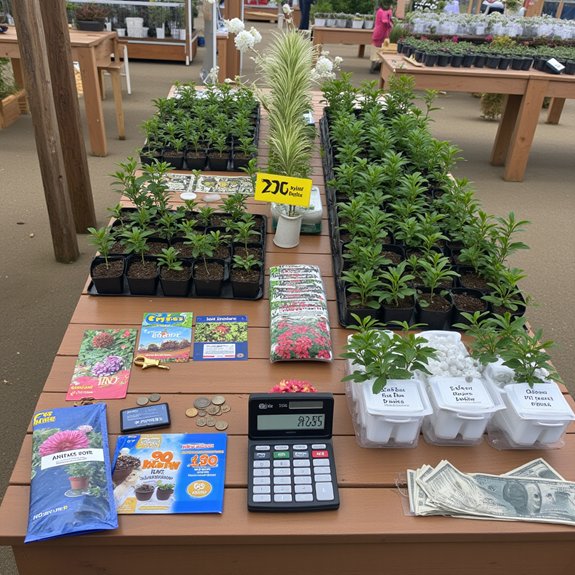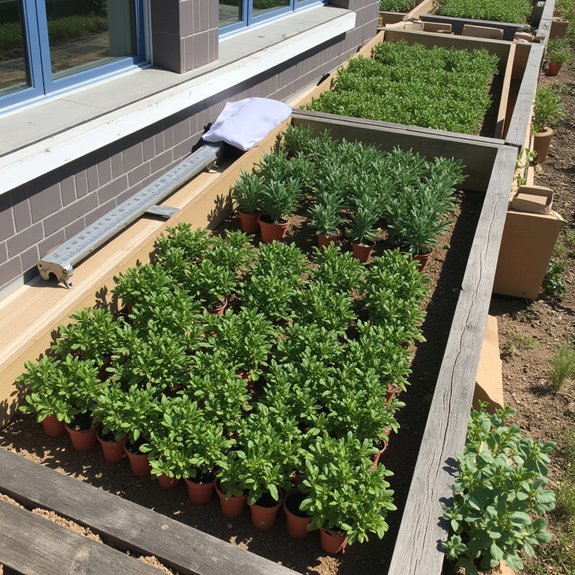Coincidentally, you’ll face this same dilemma whether you’re planning a sprawling vegetable garden or a simple herb collection on your windowsill. Starting seeds costs roughly 90% less than buying established plants, but you’ll need 6-12 weeks of indoor growing time before transplanting. Meanwhile, nursery plants offer instant gratification at $3-8 per specimen, though your variety choices shrink dramatically. The math seems straightforward, but there’s a hidden complexity that could completely change your approach.
Contents
- 1 The Financial Factor: Budget Breakdown of Seeds vs. Plants
- 2 Time Investment: Understanding Growth Cycles and Scheduling
- 3 Space Requirements: From Windowsills to Garden Beds
- 4 Plant Selection: Variety vs. Availability Trade-offs
- 5 Method Matching: Which Plants Thrive Best From Each Approach
- 6 Long-term Crops: When Patience Pays Off
- 7 Making the Choice: Key Factors for Your Garden Success
The Financial Factor: Budget Breakdown of Seeds vs. Plants

Your wallet will likely appreciate the math behind seed starting versus buying established plants. Seed packet pricing typically runs around $5 for 500 seeds, while plant purchase costs often match that same $5 for just one established specimen. You’re fundamentally getting 500 potential plants for the price of one. This cost difference becomes dramatic when you’re filling larger garden spaces or want multiple varieties. However, you’ll need to factor in additional expenses like potting soil, containers, and potentially grow lights. For extensive gardens, seeds offer significant savings, but smaller plots might not justify the upfront investment in starting equipment.
Time Investment: Understanding Growth Cycles and Scheduling
While seeds offer impressive cost savings, they demand a completely different relationship with time than grabbing ready-to-plant specimens from the nursery. Understanding growth cycles becomes critical when you’re starting from scratch. Eggplant seeds need a February start for May transplanting, while tomatoes require 6-8 weeks indoors before your last frost date.
Scheduling considerations multiply when you’re managing multiple varieties with different germination timelines. You’ll need to plan backward from your desired harvest dates, factor in hardening-off periods, and coordinate transplanting schedules. Meanwhile, nursery plants let you skip these complex timing calculations entirely.
Space Requirements: From Windowsills to Garden Beds

Where will you house dozens of tiny seedlings during their vulnerable first weeks of life? Space becomes your biggest constraint when starting seeds indoors. You’ll need dedicated areas, from sunny windowsills to elaborate grow tents with artificial lighting. Most gardeners require 2-4 square feet per seed tray.
Indoor gardening setups range from simple to sophisticated. Basic windowsill operations work for 10-20 plants, while grow tents can accommodate hundreds. Consider your available space realistically before committing to seed starting.
Direct seeding eliminates indoor space requirements entirely, making it perfect for cramped apartments or overflowing households.
Plant Selection: Variety vs. Availability Trade-offs
When you’re craving that rare purple cauliflower or exotic cherry tomato variety, seeds open up possibilities that local garden centers simply can’t match. Big box stores typically stock 10-15 common varieties, while seed catalogs offer hundreds of options to satisfy specific variety preferences.
However, buying plants means you’re limited to whatever’s on the shelf. Local nurseries usually carry more diverse selections than chain stores, but even they follow seasonal trends and popular demands.
Seeds let you grow heirloom varieties, disease-resistant strains, and unique cultivars that’ll never appear in store displays, giving you complete control over your garden’s diversity.
Method Matching: Which Plants Thrive Best From Each Approach

Just as each plant has unique growing requirements, different species respond better to specific starting methods based on their root systems and growth patterns. Root vegetables like carrots, radishes, and potatoes hate transplanting, making direct seeding your only option. Fast-growing seed varieties such as beans, peas, and squash germinate quickly outdoors.
However, heat-loving plants like tomatoes, peppers, and eggplants benefit from indoor seed starting. Their plant preferences favor controlled environments before outdoor transplanting. Perennials like asparagus and fruit trees perform better as established plants, giving you years of head start on harvest time.
Long-term Crops: When Patience Pays Off
Some plants operate on nature’s slowest timeline, requiring multiple years before you’ll see meaningful results from your gardening investment. Asparagus crowns need four patient years before delivering a measurable harvest, making established plants worth the extra cost. Crop longevity becomes essential when considering biennial flowering perennials like foxglove and hollyhock, which won’t bloom until their second year from seed.
Fruiting trees test your patience cultivation skills even further. Peach and apple trees demand several growing seasons before producing their first meaningful crop, making nursery purchases considerably more practical than starting from seed.
Making the Choice: Key Factors for Your Garden Success
Your gardening success hinges on four critical factors that’ll determine whether you should reach for seed packets or head to the nursery. First, consider your available space—seed starting requires dedicated areas from windowsills to grow tents, while buying plants skips this requirement entirely. Second, evaluate your budget carefully. Seed packets cost around $5 for 500 plants, whereas individual plants cost the same amount. Third, assess your gardening experience and patience level. Finally, prioritize seed quality and timing requirements, especially for crops needing early starts like eggplant in February for May transplanting.
